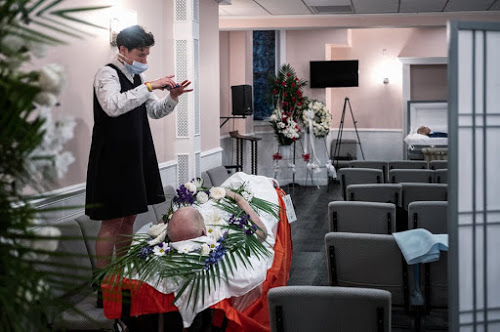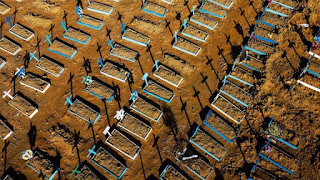| Relatives of a COVID-19 victim being shown the body virtually before cremation in New York City. Misha Friedman/Getty Images |

“…funerals can simultaneously articulate and configure future or prospective memories, including afterlife journeys, spiritual regeneration, and social continuity, through the choice of matter and things associated with the cadaver. Indeed, the power of mortuary commemoration in past and present societies is such that it can simultaneously draw upon multiple temporalities and scales of memory involving both the past and the future to define death and the dead.”[I]
Referring to the late 5th and 6th centuries AD Anglo-Saxon cremation practices, William suggests that there are various technologies of remembrance including ‘pyre-goods’ that made remarkable imprints of the dead after the cremation. These technologies, often, he suggests were not merely ‘objects of memory’ or artefacts that contained biographical details of the deceased but rather understood as the “commemorative catalyst”, which gave them a unique identity. Following the clue from this passage and recurring importance of death culture, this article focuses on the contemporary nature of death, mourning, and remembrance in times of the COVID-19. The article briefly focuses on two specific contours of death. First, it emphasises on the significance of death, processes, and modes of remembrances in times of the COVID-19. Second, it thinks about how death culture has dramatically changed – removing possibilities of what I call “last rites of passage” to death. In doing so, the article reflects on limited sources and reportage on death in the past few months. It moves away from the confines of defining death as a merely numerical count for tracing trends of the virus to deep emotional imprint, touch, intimacy, and unimaginable scales of loss.

To illustrate this, the article shows how the processes of death and remembrance are shaped by the presence of the virus through a brief reflection on two vignettes: council regulation in the United Kingdom and the satellite image of the cemetery in Iran. They are both unrelated by the structure of specific inquiries, needs, and governance, but related by the technologies and modalities of the death. Far from flowers and frills, tears and mourning, each case offers an insight into how death has now become a question of bureaucratic and sanitary management. While, the case of the UK council reflects on the organisation and wider engagement with values of the community related to the deaths; the case of Iran takes us away to new plains of imagination, where the new technologies such as the satellite photographs circulated by media informed the scale of deaths with no details of human intimacy. Each case, therefore, shows us new oddity in the death culture.
Case 1: UK Council Regulations and Spectre of Death
After the PM Boris Johnson announced the lockdown, people began standing in the long queue outside the supermarkets as shelves emptied. The following days witnessed unprecedented scenes of how busy streets in London dried up and was enveloped by a widespread eerie silence. Many animals took to the streets – London urban fox, cuckooing of birds, and ducks washing away by the walkways of the canal moved seamlessly. Giant piles of waste around the corner of every neighbourhood rose as everyone sat in their house. Something more serious was unfolding – an intense bureaucracy around the death management of disposing COVID infected deceased bodies. Under the Coronavirus Act 2020, which came into force on 26th March, the government laid out specific requirements, procedures, and provisions regarding the death certification and cremation. England, Wales, Scotland, and Northern Ireland followed specific instructions under section 15 that dealt with the death of corona patients, making the act exhaustive with 30 clauses for each country.

The virus not only changed how we lived but also the structure that supported everyday management of deaths – allowing new forms of the requirement for the cremation process of COVID deceased. A series of notifications related to the process cremation was released. Each notification starting from 23rd March until 7th June prescribed the conduct of cremation. The virus led to a change in “The Cremation (England and Wales) Regulation 2008” by “modernising and consolidating all previous regulations” through the Coronavirus Act 2020.
Each death has context and community. Each body value a last rite of passage. This means everyone follows their traditional burial or cremation practice. In considering this, the act laid out specific provisions – “designated local authorities must have regard to the desirability of disposing of a dead person’s body or other remains”.
“This trauma of coronavirus has changed how we live and die, and it has changed funerals” (BBC, 4 April). Far from mourning, the bureaucracy of death is tiresome after a loss. So, what does it mean to lose someone during the pandemic, when some of the most minimum course of humanity is removed? How does one manifest grief, articulate their feelings for the loved ones by catching a glance from 6 feet away with only a few members and without any touch. In thinking about the new forms of “commemorative catalysts”, do we still have the opportunity to signal a memorial that embodies the person through their last counts in life. In so far, there is a need to imagine a more creative, perhaps healing, or recuperative form of memorialisation that would not simply contain a biographical index but offers a space for engagement to reconcile the trauma. In doing so, the families, friends, and communities can find closer through memorial – advancing their need to communicate. The virus is invisible in killing those who are present with us in flesh and blood.
Case 2: Iran and the Satellite Image of the Burials
On February 2, 2020, Iran announced two cases of Coronavirus. In the initial period of the spread, the government had underplayed the scale and implication of the virus – a trend seems parallel in many other countries. However, soon after the country was engulfed into widespread infection and deaths – leading to declare it an emergency. Various videos began to emerge capturing the scale of deaths and pilling up of bodies in the hospitals. Another dimension that briefly emerged as the source to confirm the rise of COVID deaths was satellite images of burial pits. These images captured the extension of burial pits, which was reportedly smaller in size until early this year. These images were provided to the New York Times by the US space technology Maxar, which confirmed the increasing capacity of burial. The confirmed number of deaths jumped in thousands within a few days – making Iran one of the hotspots for coronavirus outside China.
These visuals, as it were, captured a fraction of the loss that ravaged the lives of the people. It served as an illustration of the news that concentrated on the spread of infection and the scale of deaths. Within weeks, the world moved the camera to the other countries that saw a rise in the number of deaths and infections. As if the trail of virus made the lives of people more visible than bodies itself – as if the humans who are living and embodied relationship served as an extension to explain the phenomena of the virus. What is important about the case of Iran and visuals of burial pits that undercuts a recurring theme of death culture sustained both by the popular media and collective memory of world citizens? What does it mean to witness death through a far-sighted object located in the spatial-temporal dimension, which is both sensorially and affectively indifferent to the social context that humans cohabit?

Beyond the scope of media, visuals, and reportage, the prevalence of satellite imagery in this instance also affects the community’s response to death. It obfuscates the details of loss (social entanglements, cultural values), the essence of trauma, and importantly, the shift in the death practice. In so far, the world knows that burial pits were extended because the coronavirus was widespread in Iran. It allows the world to move forward to another catalogue.
Imagining New Ways of Remembering:
Everyone around the world is drawing on their reserve of emotional resources, material capacities, and importantly, the grit to find closure from the despotic uncertainty of this time caused by an unseen enemy – the virus. This invisibility of the virus has held the humankind in the grip of an unusual emptiness, isolation, and sense of overwhelming uncertainties. In particular, it has made a remarkable shift in the way we articulate and intimacies for each other.

In the case of the UK council regulation, it seems that the bureaucratic structure is widely robust and often lent detailed plans of burial procedure. While, the case of Iran as reported widely raises the impending question of death and visibility – making a cursory observation of the details that underwent in the process of burial beyond satellite visuals. These two examples are limited in the scope to explain the phenomena. In the recent past, we have seen some harrowing content related to the management of the dead bodies in India – raising concerns about how the last rites of the deceased are tossed out with disrespect. Each case speaks volumes about how death has become a matter of management – far removed from grief and mourning.
Unfortunately, these cases inform a worrying impact of the virus on societies. A Virus is transient in making our wounds visible that run deeper. The abysmal trauma which defines the departure during the pandemic is serious than it seems. Deaths are not glossary to a count. It is an intimate loss of those who make our lives seen, heard, and loved. So, in what ways can we imagine developing a “commemoration catalyst” that not only memorialise the departure of loved ones but also offers reconciliation – a passage to attain comfort without their touch and intimacy? In this new age of remembering and forgetting, as Sarah Tarlow, explores in her work, we must think of ‘gravestones as the embodiment of history and archaeology, text and artefact, where they become both deliberately communicative and unintentionally revealing’.[ii]